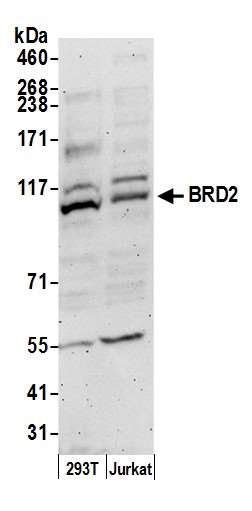Anti-BRD2 Antibody (13020)
Data
 Detection of human BRD2 by western blot. Samples: Whole cell lysate (50 µg) from HEK293T and Jurkat cells prepared using NETN lysis buffer. Antibody: Affinity purified goat anti-BRD2 antibody 13020 (lot 13020-2) used for WB at 0.1 µg/ml. Detection: Chemiluminescence with an exposure time of 3 minutes.
Detection of human BRD2 by western blot. Samples: Whole cell lysate (50 µg) from HEK293T and Jurkat cells prepared using NETN lysis buffer. Antibody: Affinity purified goat anti-BRD2 antibody 13020 (lot 13020-2) used for WB at 0.1 µg/ml. Detection: Chemiluminescence with an exposure time of 3 minutes. - -
- -
Antibody DetailsProduct DetailsReactivity Species Human Host Species Goat Immunogen Synthetic peptide representing a portion of the protein between the putative nuclear localization signal and the ET domain Product Concentration 1.0 mg/ml Formulation Tris-citrate/phosphate buffer, pH 7 to 8 containing 0.09% Sodium Azide State of Matter Liquid Product Preparation Purified by immunoaffinity chromatography Storage and Handling This product is stable at 2 -8°C for 1 year. Country of Origin USA Shipping Next Day 2-8°C Applications and Recommended Usage? Quality Tested by Leinco Immunoblotting: 0.025 - 0.1 ug/mL.Detection of human BRD2 in RIPA extract (10ug) of HeLa cells untreated (-) or treated (+) with calf intestinal phosphatase with #13020 at 0.05ug/mL. Each investigator should determine their own optimal working dilution for specific applications. See directions on lot specific datasheets, as information may periodically change. DescriptionSpecificity This antibody reacts with human BRD2. The specific epitope is in the region between aa 550 and 600 of human BRD2. Based on 100% sequence identity, this antibody is predicted to react with Bovine, Rhesus Monkey, Gorilla, White-tufted-ear marmoset, Crab-eating macaque and Northern white-cheeked gibbon. Antibody is affinity-purified with an epitope specific to BRD2 immobilized on solid support. Background BRD2 (bromodomain-containing 2) is a nuclear mitogen-activated kinase that plays a role in transcription of cell-cycle- regulated genes by functioning as an adapter protein that recruits E2F and chromatin remodeling factors to E2F response elements. Antigen DetailsFunction May play a role in spermatogenesis or folliculogenesis (By similarity). Binds hyperacetylated chromatin and plays a role in the regulation of transcription, probably by chromatin remodeling. Regulates transcription of the CCND1 gene. Plays a role in nucleosome assembly. {PubMed:18406326}. NCBI Gene Bank ID UniProt.org Research Area Enzymes References & CitationsTechnical Protocols |


